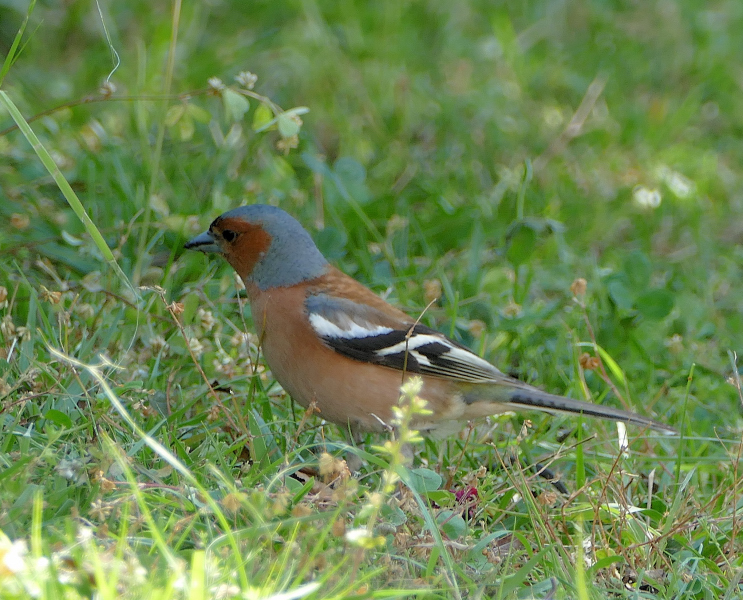The chaffinch (Fringilla coelebs), commonly known as the Eurasian chaffinch, is a species of bird in the finch family, Fringillidae. It is widely distributed across Europe, Western Asia, and parts of North Africa, and is one of the most common and easily observable birds in forested areas, gardens, parks, and agricultural lands. The chaffinch is easily recognized by its vibrant plumage, which varies significantly between the sexes. During the breeding season, the male has brightly colored plumage, including a grey head, a red-orange throat and chest, while the female has a more subdued, less vibrant plumage with brown tones and a lighter underside.
The chaffinch is a medium-sized bird, measuring between 14 and 16 cm in length with a wingspan of approximately 24-26 cm. Its weight ranges from 18 to 24 grams. The chaffinch is territorial, especially during the breeding season, and is known for its characteristic melodious song, which the male uses to mark his territory and attract females.

Scientific Classification
Physical Characteristics and Structure
Fringilla coelebs is a medium-sized bird with a slender, lightweight body, perfectly adapted for its diet, which primarily consists of seeds but also includes insects during the breeding season. The bird’s head is of moderate size, with a conical beak that allows it to eat a variety of seeds, its main food source. Its wings are short and broad, ideal for quick flights between trees or for moving between shrubs and grassy areas. The tail is long and slightly forked, aiding in rapid directional changes during flight.
The bird's legs are short but strong, well adapted for walking through grass and perching on branches. Its plumage, made mostly of keratin, serves both a protective and thermoregulatory function, providing optimal protection against temperature fluctuations.
Physical Properties
Fringilla coelebs has a body length ranging from 14 to 16 cm, and its wingspan reaches approximately 24-26 cm. Its weight varies between 18 and 24 grams, making it light and agile, ideal for quick, short flights between trees and shrubs. While not a long-distance migrator, the chaffinch moves southward during the colder months to find food and milder temperatures, though it does not venture far from its breeding grounds.
The bird's conical beak is a key adaptation for consuming seeds, though the chaffinch will also eat insects, which provide an important protein source during the breeding season. The male’s colorful plumage during the breeding season helps to distinguish the sexes and plays a role in mate selection.
Reproductive Process and Biological Cycle
Fringilla coelebs is monogamous during the breeding season. Males attract females with their melodious song and courtship displays, which include a series of flights and wing gestures to impress the female. The female builds the nest, usually in shrubs or trees, using grass, moss, and twigs, and lines the interior with soft materials to protect the eggs from temperature fluctuations and predators.
The female typically lays 3 to 5 eggs, which are incubated for about 11-13 days. During this period, the female is mainly responsible for incubation, while the male provides food. Once hatched, the chicks are fed a diet of seeds, although they are also given insects during the early stages of growth. After about two weeks, the chicks become capable of flight and gradually become more independent, though they remain close to the nest for a while before fully venturing out.
The breeding cycle of Fringilla coelebs is typically annual, with one generation produced during spring and summer, while the species enters a reproductive quiet phase in the winter.
Ecology and Environmental Role
Fringilla coelebs plays an important ecological role, especially in seed dispersal. Feeding mainly on seeds, it helps to disperse plant seeds, aiding in the growth of new plant species. Its diet, which varies depending on the season and food availability, also includes insects, contributing to the regulation of small invertebrate populations.
The chaffinch is also an important prey species for various predators, including raptors, carnivorous mammals, and snakes. Its ability to camouflage within vegetation and its quick flight maneuvers make it difficult for predators to catch, but it remains an important prey species in the food chain.
Environmental and Conservation Considerations
Fringilla coelebs is an abundant species and is not considered threatened. However, its population may be influenced by habitat loss due to increasing urbanization and the reduction of green spaces. The destruction of woodlands and the conversion of agricultural lands into residential areas reduce the natural habitats where the chaffinch nests and forages.
Climate change could impact the species by altering food availability and the breeding season, changing the timing of favorable periods for reproduction. Conservation efforts should focus on protecting the natural habitats of Fringilla coelebs, such as forested areas and agricultural lands, to ensure the species continues to thrive. The creation of green corridors in urban areas and sustainable land management practices in agricultural settings are also important solutions to support the species' future.
Additionally, establishing protected areas and monitoring chaffinch populations can help maintain healthy populations in the long term.



